
Morningstar Boats
About the Technology
5083 Alloy
This material offers the highest strength of all non heat treatable aluminium alloys and is used by many military and commercial vessels.
The entire hull structure, including keel and support frames, of the Morningstar series of boats are made with marine grade 5083 alloy. Many similar sized boats on the market today uses the 5052 alloy. While 5052 is easier to form, 5083 offers roughly 50% higher tensile and yield strengths.
Tensile strength is the maximum stress that a material can withstand while being stretched or pulled before necking.
Yield strength is the stress at which a material begins to deform plastically. Once the yield point is passed, some fraction of the deformation will be permanent and non-reversible.
Practically speaking, this means the same boat made with 5083 can withstand greater stress in a collision before cracking or deforming, than a boat made with steel, fibreglass or aluminium 5052 alloy.
5083 also has excellent weldability. According to ESAB (a major manufacturer of welding equipment), compared to the respective base alloy, the as-welded 5083 alloy loses only 7% of its tensile strength, while welded 5052 is between 19% to 36% weaker. Heat treatable alloys such as 6061, can have a loss of strength of around 80% near welds.
With our over 20 years of experience in the field of metal forming and significant investment in capital equipment, we have the capacity to handle materials that may be unwieldly for smaller or less experienced manufacturers.
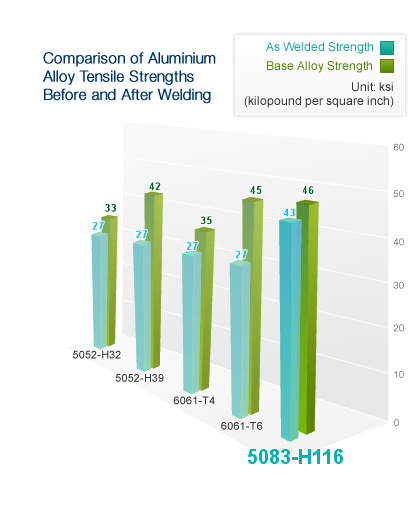
Hydro Hull
Fibreglass curves with the strength of aluminium.
The Morningstar Boats are revolutionary because of their unique aluminium plate formed hulls. During forming, thousands tonnes of force is applied on premium aluminium plates and the material becomes a little liquid-like, evenly spreading on dedicated design dies. Flat plates become complex shapes. This allows the single plate bottom of Morningstar Boats to incorporate reverse chines, strakes, and variable deadrise, and eliminate an external extrusion keel. Additionally, side plates and gunwales can now be integrated into a streamline shape with second chine and flared-bow. Together, these formed plates give the hull outstanding hydraulic properties, static and dynamic. That’s why we call it the Hydro Hull.
Strength is another important characteristic of the Hydro Hull. The formed plates act as a strong outer shell, an exoskeleton. This ‘unibody’ concept might seem familiar, because it is highly popular with high-end sports cars, airplanes, automobiles and top-end bicycles. No longer dependent on frames alone to provide structural strength, the net result is a stronger, lighter and more rigid integral structure. Special folding technology are also used to construct stiffeners and transom. Folded stiffener system and transom dramatically decrease welding and increase rigidity and durability.
Hydro Hull take things another step further: a rigid shell means robot welding is now a possibility. Robots are blind and can only follow fixed paths. If the deviation between pieces is greater than 1mm, parts cannot be welded by robots. High-tech forming turns flexible plates into self-rigid exoskeletons and keep the deviation under control. The end effect is that we are able to consistently reproduce identical welds on the Hydro Hull time and time again.
Utilising forming process that minimize number of pieces required, such as by turning the side plate and gunwale into one, we avoid the many structural and weld defects associated with traditional methods.
In the past, complex and therefore usually more hydrodynamic hull designs are reserved for the fibreglass boats, while aluminium boats are limited to simple developable surfaces. Not anymore.
With our experience in the field of metal forming, we overcome these obstacles and present to you an aluminium hull that handle excellently in the water. The hydro hull combine the aesthetic appearance of a fibreglass hull design with the robustness and light weight of aluminium.
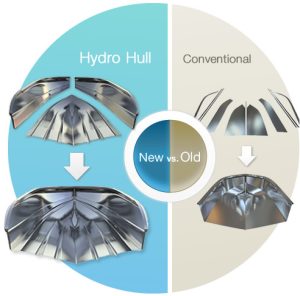
Origid Design
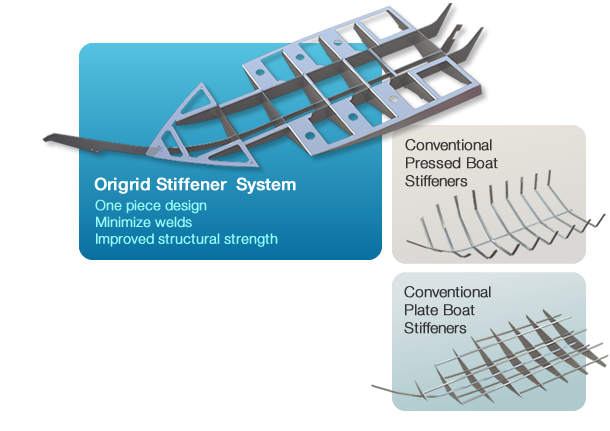
Robot Welding
We utilise high precision automatic robotic arms and welding machines in most welding processes. Every weld is our best performance.
Are you ever concerned about whether the welds on your boats are done by a pro or a newbie apprentice? With Morningstar Boats, you won’t have to worry no more.
Combining our unique forming technologies that produce complex surfaces with high accuracy laser cutting machines, we feed the robotic arms with identical pieces. These automatic robotic arms follow pre-programmed paths and guide the welding torchs to exact positions. The welding machines themselves have myriads of variables, some are set to predetermined optimal values while others are self-adjusting to produce optimal results.
These changes in speed, current, voltages and other variables are dynamic. They occur during the welding process at a pace, steadiness and exactness that are not humanly possible. The end effect is that we are able to consistently reproduce identical welds time and time again, taking human errors out of the equation as much as possible.
Furthermore, during the product development as well as the quality assuance stages, we repeatedly verify our test pieces and products with destructive and non-destructive tests. Employing methods including x-ray, ultrasound and liquid penetrant inspections, our TCWI-certified weld inspectors have the know-how to identify and rectify defects, delivering top quality weld results to you.
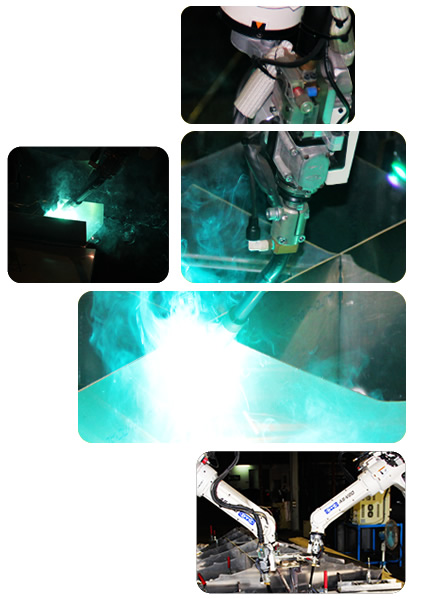
Superior Riding
We are all looking for a boat with superior riding qualities: easy planing, soft and dry rides along with the ability to keep on track. Geometric limitations of the conventional V bottom makes it difficult for normal aluminum boats to own all these properties simultaneously. Thanks to forming technology, Morningstar Aluminum Boats are able to have all by incorporating designs that used to be exclusive for modern fibreglass boats.
These include bow-to-aft reverse chines, twin planing strakes, and a true variable deadrise on its single-piece bottom plate. This gives Morningstar Boats the ability to plane easily, stay on track, and give you soft and dry boating experience.
Easy and Stable Planing
When you push the throttle, the outboard engine will drive the boat forward, while the water gives the boat a lifting force to plane. Bow-to-aft Reverse chines and strakes on the Morningstar bottom plate help to conserve more lifting-force and allow the boat to plane quicker and increase its cruising stability.
Superior Traction
The axe-like forefoot allows Morningstar Boats to cut into waves briefly, while deeper V near keel slices in water creating a stable track. When turning, particularly at high speeds, the last thing you want is your boat slipping sideways and not making the turn as you would expect. The reverse chines and strakes on Morningstar bottom plate act like tire treads on your car wheels. These help to hold the boat steady.
Soft and Dry Ride
You will be impressed by how soft and dry rides work on Morningstar boats. The axe-like forefoot and deep V give a smooth entry. Flattened V, strakes, and reverse chines act like brakes gradually slowing down the boat and preparing for another raise. At the same time, water is deflected away from the boat at a very low angle, giving you a soft and dry ride.
Second Chine, flared side plates, and extra-volume bow area design give you a second line of defense when confronting rougher water.
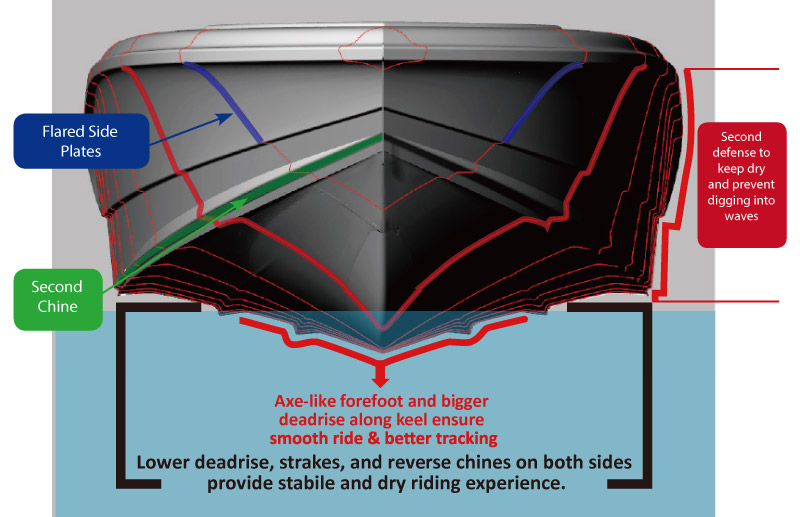

Superior Strength
Premium material, strong structure, and quality construction are three foundations in building a boat with real strength. To reach this ultimate goal, Morningstar boats adopts a revolutionary simple but strong hull structure, premium 5083 aluminum alloy, advanced forming technology and robot welding during construction.
Revolutionary Hull Structure
Different from conventional pressed or plate alloy boats, Morningstar boats are constructed with much fewer parts by adopting 3D formed single-plate bottoms, single-plate sides incorporating gunwales, and our patented Origrid stiffener system. Fewer parts means less welding and fewer weak links in the structure. Deduction is the code in reengineering Morningstar’s hull structure, but there is one exception, the forefoot. The forefoot is the part that usually encounters the most impact. Morningstar boats have a double-plated forefoot. A 4mm-thick 5083 alloy formed forefoot shield is fully welded over the 3mm single-plate bottom. The 4mm shield acts not only like a bumper but also an extra structure reinforcing strength at the bow.
3D Forming Technology and Robot Welding during Construction
3D forming techniques are applied to the production of the hull plates. The forming of non-developable surfaces stretches the hull slightly in multiple directions and dramatically increases its strength. At the same time, 3D geometric shapes, such as curved surfaces, strakes, and steps, are built into the plates. These shapes are not only for style or hydrodynamic purposes, but also to increase the strength of the hardened plates further. Robots are used in most of the Morningstar boats welding jobs. The precise and consistent welding works ensure every Morningstar boat reaches its design quality.


